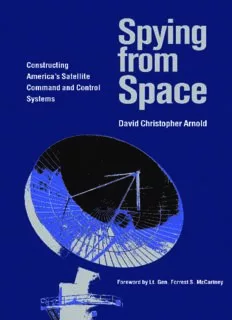
Spying from Space: Constructing America’s Satellite Command and Control Systems PDF
Preview Spying from Space: Constructing America’s Satellite Command and Control Systems
Spying from Space Number Twelve: Centennial of Flight Series Roger D. Launius, General Editor Spying from Space Constructing America’s Satellite Command and Control Systems DAVID CHRISTOPHER ARNOLD Foreword by Lt.Gen.Forrest S.McCartney,USAF,Retired TEXAS A&M UNIVERSITY PRESS COLLEGE STATION Copyright © 2005by David Christopher Arnold Manufactured in the United States ofAmerica All rights reserved First edition The paper used in this book meets the minimum requirements ofthe American National Standard for Permanence ofPaper for Printed Library Materials, Z39.48-1984. Binding materials have been chosen for durability. o Library ofCongress Cataloging-in-Publication Data Arnold, David Christopher, 1967– Spying from space : constructing America’s satellite command and control systems / David Chritopher Arnold ; foreword by Forrest S. McCartney. p. cm. — (Centennial offlight series ; no. 12) Includes bibliographical references and index. ISBN 1-58544-385-9 (cloth : alk. paper) 1. Space surveillance—United States—History. 2. United States. Air Force. Satellite Control Facility. 3. Command and control systems—United States I. Title. II. Series. UG1523.A76 2005 358'.8—dc22 2004012916 The opinions and conclusions expressed or implied within this book are those solely ofthe author and do not represent the views ofthe United States Air Force, Department ofDefense, or any other government agency. For my wife, Doreen, who let me go far, far away to the exotic British Indian Ocean Territory, where I served as operations officer at Detachment 2,750th Space Group, the Diego Garcia Tracking Station, giving rise to this project. Contents List of Illustrations ix Foreword,by Lt. Gen. Forrest S. McCartney, USAF, Retired xi Preface xv Introduction 3 “Goldstone Has the Bird!” 1 The Inescapable Premise 9 Inventing Satellite Command and Control 2 Of Vital Strategic Importance 31 Developing a Satellite Command and Control System 3 Getting Off Dead Center 63 Innovating for a Single Customer 4 Too Many Fingers in the Pie 91 Growing into a Satellite Control System 5 Unbounded Faith 116 The Technological Style of the Air Force Satellite Control Facility 6 The Pressure Cooker 140 Overcoming Momentum Conclusion 158 Inveniemus Viam vel Faciemus Glossary of Acronyms 169 Notes 173 Bibliography 193 Index 203 List of Illustrations Air Force Satellite Control Facility, 1960 6 Typical Discoverer/Coronalaunch 32 Satellite Test Center, 1960 50 New Hampshire tracking station, 1962 51 Preparing for first Corona contact, 1959 52 Original radar vans, 1959 56 Inside the original radar vans, 1959 64 Data receiver antenna, 1960 68 6593d Instrumentation Squadron at Hawaii tracking station 86 Catching a “Falling Star” 92 Recovery crew of Discoverer/Corona 14, 1960 93 Discoverer/Coronalaunch sequence 96 Payload control console, 1960 98 Hawaii tracking station, 1961 100 Control Data Corporation 160A computers, 1963 102 Multiple Satellite Augmentation Program’s FM-FM ground station, 1964 103 Farrington Highway during floods of 1968 114 Satellite Test Center, 1961 119 Blue-suit operators, 1961 121 The WS-117L ground station, 1959 127 Former location of the WS-117L ground station 128 The computer complex for Multiple Satellite Augmentation Program, 1966 130 Vandenberg tracking station, 1965 131 Integrated air force–contractor team, 1963 162
Description: